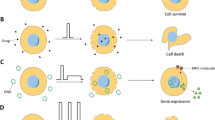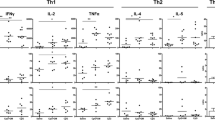Abstract
Purpose
Electrochemotherapy (ECT) is an effective local therapy of human cutaneous cancers but has no effect on distant untreated tumors. We addressed whether tumor-associated antigens released after ECT could induce an efficient systemic immunity when associated with an appropriate immunoadjuvant.
Methods and results
We first studied the nature of the cellular recruitment and the expression of various toll-like receptors (TLRs) in tumors treated by ECT. We found that ECT induced a massive recruitment of CD11c and CD11b positive cells in the tumors and a strong increase of TLR9 expression. We then tested antitumor effects of the combination: ECT followed by TLR-9 ligands, CpG oligodeoxynucleotides (CpG ODN), in three murine tumor models. We found that this combination triggered both potent local synergistic antitumor effects, on the ipsi-lateral ECT-treated tumor, and more interestingly, a systemic antitumor response on the contra-lateral untreated tumor, in the three models. The systemic protection was T-cell dependent as it was not observed in nude littermates. The combination induced tumor-specific T cell effectors in the tumor-draining lymph nodes and in the spleen which secreted significantly more gamma-interferon upon activation than with ECT or CpG ODN alone.
Conclusions
Our data show that ECT and CpG ODN synergize and induce a significant increase of the local effect and a systemic T-dependent antitumor response. Such combination constitutes a potential innovative vaccination strategy using in situ tumor-associated antigens that could eventually be translated into the clinic.






Similar content being viewed by others
References
Andersen MH, Gehl J, Reker S et al (2003) Dynamic changes of specific T cell responses to melanoma correlate with IL-2 administration. Semin Cancer Biol 13:449–459
Bauer S, Kirschning CJ, Hacker H et al (2001) Human TLR9 confers responsiveness to bacterial DNA via species-specific CpG motif recognition. Proc Natl Acad Sci USA 98:9237–9242
Belehradek J Jr, Barski G, Thonier M (1972) Evolution of cell-mediated antitumor immunity in mice bearing a syngeneic chemically induced tumor. Influence of tumor growth, surgical removal and treatment with irradiated tumor cells. Int J Cancer 9:461–469
Belehradek M, Domenge C, Luboinski B, Orlowski S, Belehradek J Jr, Mir LM (1993) Electrochemotherapy, a new antitumor treatment. First clinical phase I–II trial. Cancer 72:3694–3700
Carpentier A, Laigle-Donadey F, Zohar S et al (2006) Phase 1 trial of a CpG oligodeoxynucleotide for patients with recurrent glioblastoma. Neuro Oncol 8:60–66
Carpentier AF, Auf G, Delattre JY (2003) CpG-oligonucleotides for cancer immunotherapy: review of the literature and potential applications in malignant glioma. Front Biosci 8:115
Carpentier AF, Chen L, Maltonti F, Delattre JY (1999) Oligodeoxynucleotides containing CpG motifs can induce rejection of a neuroblastoma in mice. Cancer Res 59:5429–5432
Carpentier AF, Xie J, Mokhtari K, Delattre JY (2000) Successful treatment of intracranial gliomas in rat by oligodeoxynucleotides containing CpG motifs. Clin Cancer Res 6:2469–2473
Casares N, Pequignot MO, Tesniere A et al (2005) Caspase-dependent immunogenicity of doxorubicin-induced tumor cell death. J Exp Med 202:1691–1701
Chu RS, Targoni OS, Krieg AM, Lehmann PV, Harding CV (1997) CpG oligodeoxynucleotides act as adjuvants that switch on T helper 1 (Th1) immunity. J Exp Med 186:1623–1631
den Brok MH, Sutmuller RP, Nierkens S et al (2006) Synergy between in situ cryoablation and TLR9 stimulation results in a highly effective in vivo dendritic cell vaccine. Cancer Res 66:7285–7292
den Brok MH, Sutmuller RP, van der Voort R et al (2004) In situ tumor ablation creates an antigen source for the generation of antitumor immunity. Cancer Res 64:4024–4029
Hartmann G, Krieg AM (2000) Mechanism and function of a newly identified CpG DNA motif in human primary B cells. J Immunol 164:944–953
Heckelsmiller K, Rall K, Beck S et al (2002) Peritumoral CpG DNA elicits a coordinated response of CD8 T cells and innate effectors to cure established tumors in a murine colon carcinoma model. J Immunol 169:3892–3899
Iwasaki A, Medzhitov R (2004) Toll-like receptor control of the adaptive immune responses. Nat Immunol 5:987–995
Kawarada Y, Ganss R, Garbi N, Sacher T, Arnold B, Hammerling GJ (2001) NK- and CD8(+) T cell-mediated eradication of established tumors by peritumoral injection of CpG-containing oligodeoxynucleotides. J Immunol 167:5247–5253
Krieg AM (2004) Antitumor applications of stimulating toll-like receptor 9 with CpG oligodeoxynucleotides. Curr Oncol Rep 6:88–95
Krieg AM (2006) Therapeutic potential of Toll-like receptor 9 activation. Nat Rev Drug Discov 5:471–484
Lake RA, Robinson BW (2005) Immunotherapy and chemotherapy—a practical partnership. Nat Rev Cancer 5:397–405
Marty M, Sersa G, Garbay JR et al (2006) Electrochemotherapy—an easy, highly effective and safe treatment of cutaneous and subcutaneous metastases: results of ESOPE (European Standard Operating Procedures of Electrochemotherapy) study. Eur J Cancer Supp 4:3–13
Mekid H, Tounekti O, Spatz A, Cemazar M, El Kebir FZ, Mir LM (2003) In vivo evolution of tumour cells after the generation of double-strand DNA breaks. Br J Cancer 88:1763–1771
Meng Y, Carpentier AF, Chen L et al (2005) Successful combination of local CpG-ODN and radiotherapy in malignant glioma. Int J Cancer 116:992–997
Milas L, Mason KA, Ariga H et al (2004) CpG oligodeoxynucleotide enhances tumor response to radiation. Cancer Res 64:5074–5077
Mir LM (2006) Bases and rationale of the electrochemotherapy. Eur J Cancer Supp 4:38–44
Mir LM, Gehl J, Sersa G et al (2006) Standard operating procedures of the electrochemotherapy: instructions for the use of bleomycin or cisplatin administered either systemically or locally and electric pulses delivered by the CliniporatorTM by means of invasive or non-invasive electrodes. Eur J Cancer Supp 4:14–25
Mir LM, Orlowski S, Belehradek JJr, Paoletti C (1991) Electrochemotherapy potentiation of antitumour effect of bleomycin by local electric pulses. Eur J Cancer 27:68–72
Mir LM, Orlowski S, Poddevin B, Belehradek JJr (1992) Electrochemotherapy tumor treatment is improved by interleukin-2 stimulation of the host’s defenses. Eur Cytokine Netw 3:331–334
Mir LM, Roth C, Orlowski S et al (1995) Systemic antitumor effects of electrochemotherapy combined with histoincompatible cells secreting interleukin-2. J Immunother Emphasis Tumor Immunol 17:30–38
Obeid M, Tesniere A, Ghiringhelli F et al (2007) Calreticulin exposure dictates the immunogenicity of cancer cell death. Nat Med 13(1):54–61. Epub 2006 Dec 24
Orlowski S, Mir LM (1993) Cell electropermeabilization: a new tool for biochemical and pharmacological studies. Biochim Biophys Acta 1154:51–63
Roman M, Martin-Orozco E, Goodman JS et al (1997) Immunostimulatory DNA sequences function as T helper-1-promoting adjuvants. Nat Med 3:849–854
Sersa G (2006) The state-of-the-art of electrochemotherapy before the ESOPE study; advantages and clinical uses. Eur J Cancer Supp 4:52–59
Sersa G, Miklavcic D, Cemazar M, Belehradek JJr, Jarm T, Mir LM (1997) Electrochemotherapy with CDDP on LPB sarcoma: comparison of the anti-tumor effectiveness in immunocompetent and immunodeficient mice. Bioelectrochem Bioenerg 43:279–283
Wagner H (1999) Bacterial CpG DNA activates immune cells to signal infectious danger. Adv Immunol 73:329–368
Weigel BJ, Rodeberg DA, Krieg AM, Blazar BR (2003) CpG oligodeoxynucleotides potentiate the antitumor effects of chemotherapy or tumor resection in an orthotopic murine model of rhabdomyosarcoma. Clin Cancer Res 9:3105–3114
Zhang H, Chua KS, Guimond M et al (2005) Lymphopenia and interleukin-2 therapy alter homeostasis of CD4 + CD25+ regulatory T cells. Nat Med 11:1238–1243
Acknowledgments
We acknowledge Véronique Scott and Stéphanie Esselin for their technical assistance in the development of RT-PCRs and Elisabeth Connault for excellent technical assistance with immunohistochemistry. Grant support CNRS and Institut Gustave Roussy. Stéphan Roux was supported by Fondation pour la Recherche Médicale.
Author information
Authors and Affiliations
Corresponding author
Rights and permissions
About this article
Cite this article
Roux, S., Bernat, C., Al-Sakere, B. et al. Tumor destruction using electrochemotherapy followed by CpG oligodeoxynucleotide injection induces distant tumor responses. Cancer Immunol Immunother 57, 1291–1300 (2008). https://doi.org/10.1007/s00262-008-0462-0
Received:
Accepted:
Published:
Issue Date:
DOI: https://doi.org/10.1007/s00262-008-0462-0




